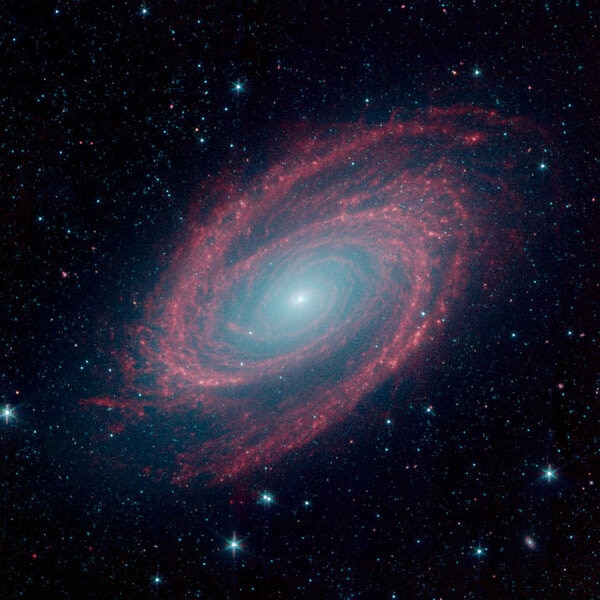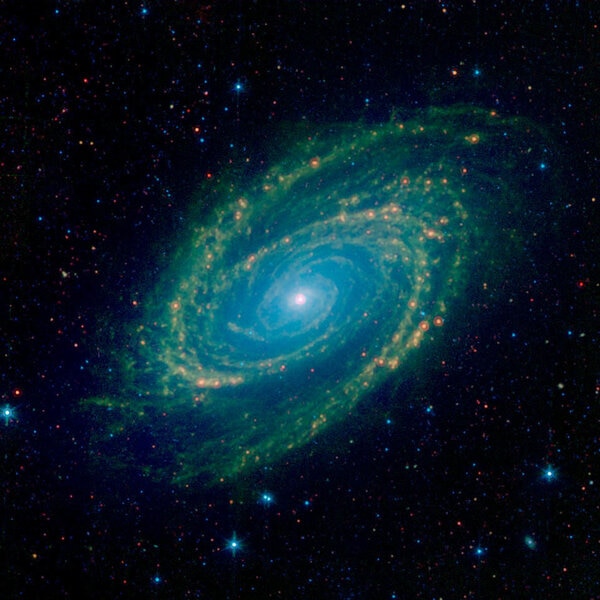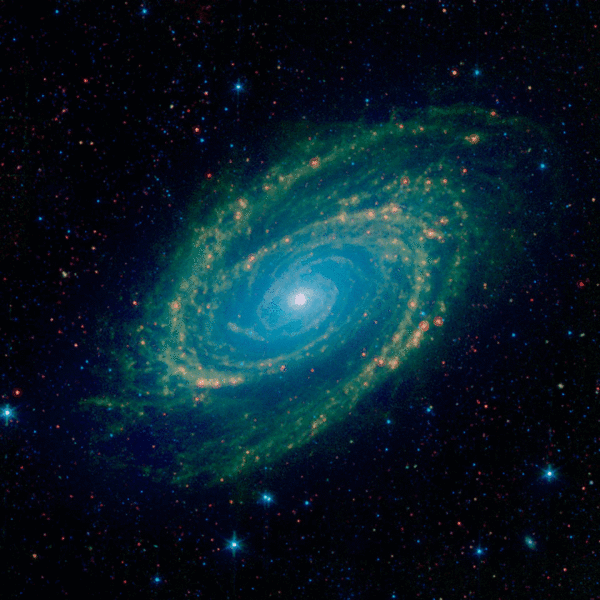Create a free profile to get unlimited access to exclusive videos, sweepstakes, and more!
M81: Spiraling dusty galactic heat

NASA's Spitzer Space Telescope launched into space in August 2003. For the 16th anniversary of this event (yeah, I know, I'm a bit late; I've been busy) they released a "something old, something new" image of the spiral galaxy M81, a classic grand-design spiral galaxy located just 12 million light years away in the constellation of Ursa Major. It's close enough and big enough that it an be spotted from dark skies easily with binocs (I've heard tales, probably true, that it's been seen naked eye!), so when you launch a telescope into space and point it toward M81, what you get is pure magnificence:
Spitzer doesn't see visible light, the kind our eyes see. Instead it sees in the infrared, light with wavelengths longer than our eye's capability to detect. This is a three-color image: what you see as blue is actually infrared light at a wavelength 3.6 microns (about 5 times longer than what our eyes can see), green is 4.5 microns, and red 8 microns. These three different IR colors tell us three different stories about the galaxy.
The center is dominated by old stars, mostly red and orange by eye. Farther out are the sprawling spiral arms, littered with dust — small grains of rocky or carbonaceous material. In visible light images this material is opaque, and looks dark. But the grains are warmed by light from bright stars in the galaxy, and warm objects give off heat in the form of infrared light. See the clumps of brighter dust along the arms? Those are active star-forming regions, huge clouds of gas and dust busily forming stars. As those stars form they warm up the dust even more, making it look brighter.
Neat, huh? But here's a thing: Spitzer can actually see in four different IR colors, not three. But in 2009 it ran out of the liquid helium coolant it was using to keep the detectors cold. It needed those because remember, warm objects emit infrared light, so if the detectors themselves aren't kept cold, they'll glow too! That produces unwanted light that would mess up the observations, so coolant was used.
Helium leaks out slowly, and when it ran out Spitzer entered what's called its "warm mission," where it could only use the short-wavelength (3.6 and 4.5 micron) channels. The 8 micron and 24 micron channels were no longer used.
But! Before that happened astronomers had observed M81 with Spitzer, so the folks who work on the images took the old 24 micron observations, cleaned them up using new techniques, and added them into this image. The result may surprise you:
Whaaaaat? It's green now!
Yeah, but that's because they changed the way the colors are displayed. 3.6 microns is shown as deep blue, 4.5 as teal, 8 as green, and the newly added 24 micron image is red.
Remember, that dust is warm and glowing brightly at 8 microns, so in the first image it made M81 look red, but now that same channel is shown as green, so it changes the overall color of the galaxy.
You can see red blobs dotting the arms now, and most of those are in the same places where the dust in the first image was brighter. Those blobs are where the dust is getting good and thoroughly zapped by extremely young, hot, and luminous stars. Those are born in the same places where star formation is vigorous, so they overlap there. But not every nebula makes stars like these, so we only see them in a handful of spots.
I created a blinking GIF animation so you can compare the two images yourself:
What else do you see changing color? Certainly the brightest dust spots are dimmer in the "red" image, but you can see other features changing too. Some of them might also be red supergiants, massive stars nearing the ends of their lives, swollen up to huge proportions. Orion's Betelgeuse and Antares in Scorpius are examples of these, and they're easily spotted in nearby galaxies.
I noticed a lot of foreground stars changing color, and some of those are actually background galaxies, probably with lots of dust in them that's easier to see in the 24 micron image.
This pair of images is a strong reminder that you have to be careful when looking at astronomical images; the colors don't always present themselves in obvious ways. You can be fooled into thinking you're seeing one thing when it's another! You have to be careful to look at the images or the journal paper about them to make sure that you're seeing what you think you're seeing. I've seen press releases that are a bit misleading this way.
But then, this advice is always true. Don't always believe what you see! Or what you hear. Or what you're told. Or or or. You get the point. And hey, it's not me telling you this. It's the Universe. So you should probably listen.





























